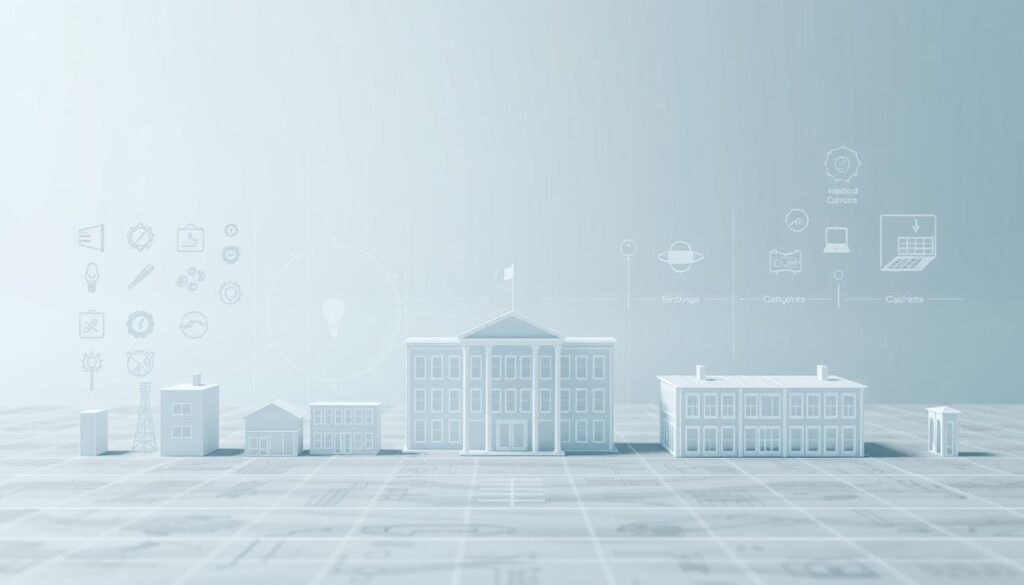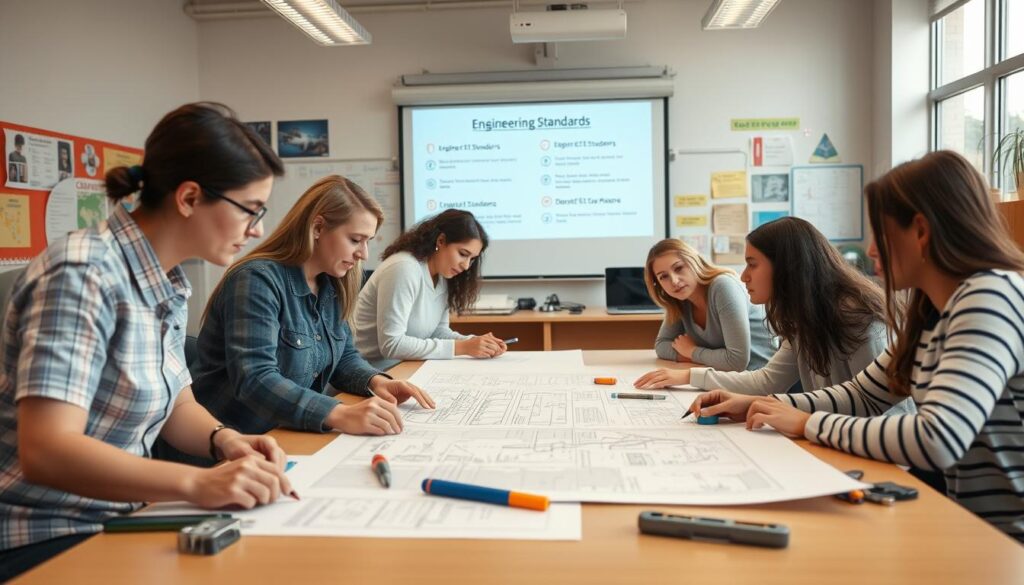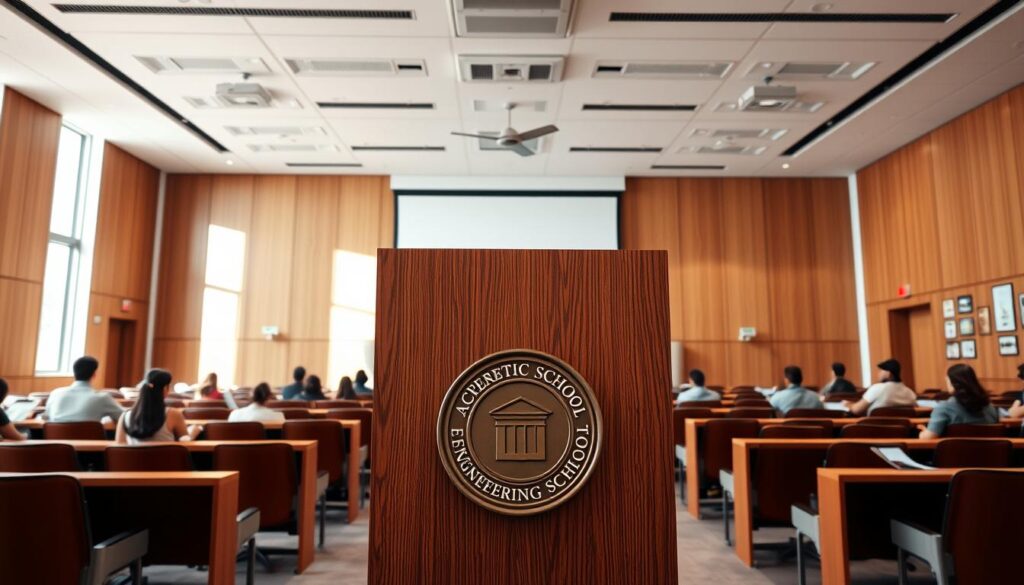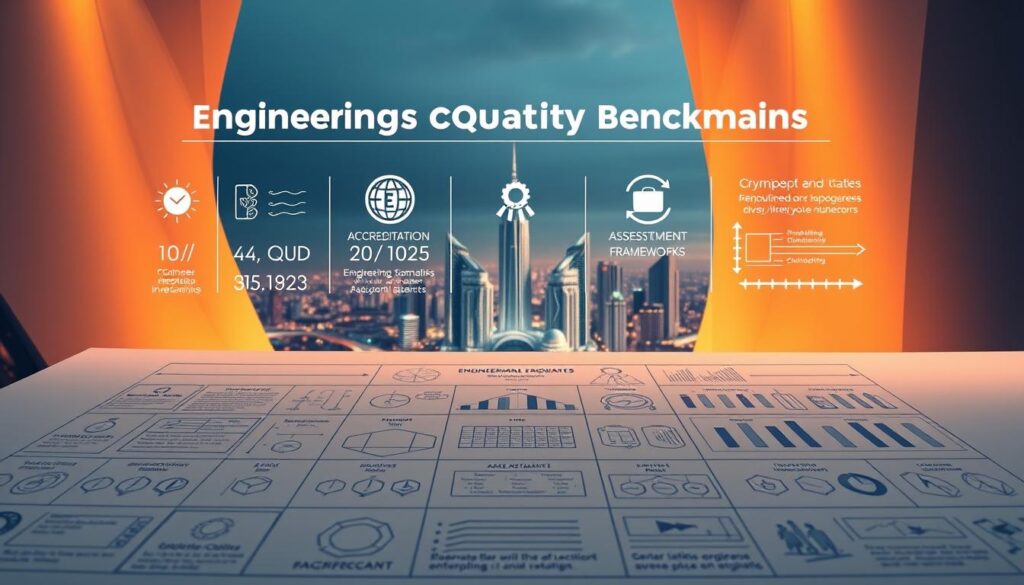The California Career Technical Education Model Curriculum Standards emphasize the need for a foundation in engineering and architecture sector pathways and occupations, highlighting the importance of quality education in this field.
Did you know that a well-structured engineering program can significantly enhance students’ career prospects and further education opportunities? The framework for delivering such programs is provided by established guidelines, ensuring that students receive a comprehensive education.
Understanding these guidelines is crucial for educational institutions to provide high-quality programs that prepare students for their future careers.
Key Takeaways
- Established guidelines provide a framework for quality engineering education.
- These standards enhance students’ career prospects and further education opportunities.
- Understanding the guidelines is crucial for educational institutions.
- A well-structured engineering program is essential for students’ success.
- Quality education in engineering is vital for the industry’s future.
Understanding Engineering Standards in Education
Engineering standards serve as a foundation for engineering education, guiding schools in curriculum development and program implementation. These standards are designed to ensure that engineering programs provide students with the necessary knowledge, skills, and competencies to succeed in their future careers.
Definition of Engineering Standards
Engineering standards in education refer to the guidelines and requirements that educational institutions must follow to ensure their engineering programs are of high quality. According to the California Career Technical Education Model Curriculum Standards, these standards are designed to provide a foundation in engineering and architecture sector pathways and occupations. By adhering to these standards, schools can ensure that their programs meet the necessary accreditation criteria, such as those set by the Accreditation Board for Engineering and Technology (ABET).
Importance of Engineering Standards in Schools
The importance of engineering standards in schools cannot be overstated. These standards are crucial because they help ensure that students receive a comprehensive education that prepares them for further study and careers in engineering. By implementing these standards, schools can enhance the quality of their engineering programs, improve student outcomes, and contribute to the development of a skilled workforce. Moreover, adherence to educational standards for engineering programs helps institutions demonstrate their commitment to providing high-quality education, which is essential for attracting students and securing accreditation.
In conclusion, understanding and implementing engineering standards is vital for schools to provide high-quality engineering education. By following these standards, educational institutions can ensure their programs are well-structured, effective, and aligned with industry needs, ultimately benefiting their students and the broader engineering community.
Key Organizations Involved in Setting Standards

Several key organizations play a crucial role in establishing engineering standards for educational institutions. These organizations work together to ensure that engineering programs meet the required standards, providing students with a high-quality education.
American Society of Civil Engineers (ASCE)
The American Society of Civil Engineers (ASCE) is one of the prominent organizations involved in setting engineering standards. ASCE has been a leader in establishing guidelines for civil engineering education, focusing on curriculum requirements that prepare students for the profession. By visiting the ASME website, educators can find resources that align with ASCE standards, although ASME primarily focuses on mechanical engineering.
National Society of Professional Engineers (NSPE)
The National Society of Professional Engineers (NSPE) plays a vital role in promoting engineering standards through professional development and ethical guidelines. NSPE’s efforts ensure that engineering professionals adhere to best practices, influencing the standards taught in educational institutions. Their resources on best practices for engineering schools are invaluable for curriculum development.
Accreditation Board for Engineering and Technology (ABET)
The Accreditation Board for Engineering and Technology (ABET) is a key accrediting agency for engineering programs. ABET’s standards are critical in ensuring that engineering programs meet rigorous educational requirements. Their accreditation process involves evaluating programs based on specific criteria, including curriculum, faculty qualifications, and facilities.
| Organization | Role in Setting Standards | Impact on Engineering Education |
|---|---|---|
| ASCE | Establishes guidelines for civil engineering education | Prepares students for civil engineering profession |
| NSPE | Promotes professional development and ethical guidelines | Influences standards taught in educational institutions |
| ABET | Accredits engineering programs based on rigorous criteria | Ensures engineering programs meet educational requirements |
By understanding the roles of these organizations, educators can better implement engineering standards in their curricula, ensuring that students receive a comprehensive education that meets professional requirements.
Benefits of Implementing Engineering Standards
The integration of engineering standards into school curricula is essential for fostering a culture of excellence. By adopting these standards, educational institutions can significantly enhance the quality of their engineering programs.
Ensuring Quality Education
Implementing engineering standards helps schools provide high-quality education that meets engineering program quality benchmarks. This is achieved through:
- Curriculum development that aligns with industry needs
- Faculty training and professional development opportunities
- Continuous assessment and improvement of program outcomes
As noted by Rich Fields in his lecture on the importance of standards, “Accreditation is a critical component of ensuring that engineering programs meet the necessary standards for quality education.” You can read more about this in the full lecture.
Enhancing Student Safety
Engineering standards also play a crucial role in enhancing student safety within educational facilities. By adhering to these standards, schools can minimize risks and create a safer learning environment.
“The safety of students and staff is paramount. Implementing engineering standards helps ensure that educational facilities are designed and maintained with safety in mind.”
Promoting Sustainable Practices
Furthermore, engineering standards promote sustainable practices in educational institutions. This includes:
- Designing facilities that are energy-efficient and environmentally friendly
- Incorporating sustainable materials and practices into the curriculum
- Encouraging students to develop innovative solutions to environmental challenges
By implementing engineering standards, schools can not only improve student outcomes but also contribute to the development of a more sustainable and responsible engineering workforce.
Types of Engineering Standards for Schools

To maintain excellence, schools follow a range of engineering standards that are crucial for their infrastructure and curriculum. These standards are designed to ensure that educational institutions provide a safe, conducive, and high-quality learning environment.
Curriculum Standards
Curriculum standards are a critical component of engineering standards, outlining what students should know and be able to do. According to the design standards set by educational authorities, curriculum standards define the knowledge and skills that students should acquire through their engineering programs.
Key aspects of curriculum standards include:
- Defining learning objectives
- Outlining the scope of engineering knowledge
- Establishing assessment criteria
Facility Standards
Facility standards ensure that the physical environment in which students learn is safe and conducive to learning. These standards cover aspects such as building design, infrastructure, and maintenance.
| Aspect | Description | Importance |
|---|---|---|
| Building Design | Layout and architecture of school buildings | Enhances learning environment |
| Infrastructure | Quality of facilities such as classrooms, labs, and libraries | Supports educational activities |
| Maintenance | Regular upkeep of facilities | Ensures safety and longevity |
Safety Standards
Safety standards are designed to protect students and staff from potential hazards. These standards are crucial for preventing accidents and ensuring a secure learning environment.
“Safety is not just a necessity, it’s a responsibility.” –
Safety standards encompass a wide range of measures, including emergency preparedness plans, safety protocols, and regular inspections.
The Role of Technology in Engineering Standards
As technology advances, its role in shaping engineering standards in schools becomes increasingly significant. The integration of technology in engineering education is not just about keeping pace with the latest developments; it’s about enhancing the learning experience and preparing students for a future where technology continues to evolve at a rapid pace.
Integration of Tech in Engineering Education
The use of technology in engineering education is multifaceted, offering a range of tools and resources that can enhance teaching and learning. From simulation software to online collaboration platforms, technology is being used to create a more engaging and interactive learning environment. For instance, Computer-Aided Design (CAD) software is being used to teach students the principles of design and engineering, allowing them to create and test their designs in a virtual environment.
According to
“Technology is not just a tool, it’s a catalyst for change in education.”
This change is evident in the way technology is being integrated into engineering curriculums, making them more relevant and aligned with industry needs.
Online Resources and Learning Platforms
Online resources and learning platforms are playing a crucial role in supporting engineering education. These platforms provide access to a wealth of educational content, including video lectures, interactive simulations, and virtual labs. For example, platforms like GitHub and OpenStax offer a range of resources that can be used to support teaching and learning in engineering.
| Resource | Description | Benefit |
|---|---|---|
| CAD Software | Design and engineering software | Enhances design skills |
| Online Learning Platforms | Access to educational content | Increases flexibility in learning |
| Simulation Tools | Virtual testing and experimentation | Reduces costs and enhances safety |
The effective integration of technology in engineering education requires careful planning and implementation. Schools must ensure that they have the necessary infrastructure and support in place to make the most of these resources. By doing so, they can provide students with a high-quality engineering education that prepares them for success in their future careers.
Compliance with Local and Federal Regulations

Compliance with local and federal regulations is essential for the accreditation and success of engineering programs in educational institutions. Schools must navigate a complex web of regulations to ensure their programs meet the required educational standards for engineering programs.
To achieve this, understanding state-specific regulations is crucial. Each state may have its own set of rules and guidelines governing engineering education, including curriculum standards, facility requirements, and safety protocols. For instance, some states may require engineering programs to be accredited by specific bodies such as the Accreditation Board for Engineering and Technology (ABET).
Understanding State Regulations
State regulations can vary significantly, and schools must be aware of the specific requirements in their jurisdiction. This includes understanding the role of state education departments and professional engineering societies in setting and enforcing standards. Compliance with these regulations is not just about avoiding legal issues; it’s also about ensuring that students receive a high-quality education that prepares them for professional practice.
Navigating Federal Compliance
Navigating federal compliance involves understanding and adhering to federal laws and regulations that govern engineering education. This includes laws related to accessibility, discrimination, and financial aid, among others. Federal compliance also intersects with state regulations, requiring schools to be vigilant in their adherence to both state and federal requirements to maintain engineering school accreditation.
To effectively navigate these regulations, schools can leverage resources from professional organizations and government agencies. These resources can provide guidance on the latest regulatory requirements and best practices in engineering education.
Incorporating Engineering Standards in Curriculum
The integration of engineering standards into educational curricula is essential for preparing students for the demands of the engineering profession. By incorporating these standards, educational institutions can ensure that their students receive a comprehensive education that aligns with industry expectations.
Project-Based Learning Approaches
One effective method for incorporating engineering standards into the curriculum is through project-based learning approaches. This method involves providing students with hands-on experience, enabling them to apply theoretical knowledge to real-world problems. According to a study published in the STEM Education Journal, project-based learning can significantly enhance student engagement and understanding of engineering concepts https://stemeducationjournal.springeropen.com/articles/10.1186/s40594-020-00210-x.
Key Benefits of Project-Based Learning:
- Enhanced student engagement
- Improved understanding of engineering concepts
- Development of problem-solving skills
Focus Areas in Engineering Education
When incorporating engineering standards into the curriculum, it is crucial to identify the focus areas that will have the most significant impact on student learning outcomes. Some of the key focus areas include:
| Focus Area | Description |
|---|---|
| Curriculum Design | Ensuring that the curriculum is aligned with engineering standards and industry needs. |
| Hands-on Learning | Providing students with opportunities for hands-on learning and project-based experiences. |
| Assessment Methods | Developing assessment methods that accurately measure student understanding of engineering concepts. |
By focusing on these areas and incorporating project-based learning approaches, educational institutions can ensure that their students receive a high-quality engineering education that meets industry standards.
Teacher Training and Engineering Standards

Teacher training is essential for educators to effectively integrate engineering standards into their curriculum. Providing teachers with the necessary skills and knowledge enables them to deliver high-quality engineering education that meets the required standards.
Professional Development Opportunities
Professional development opportunities are crucial for teachers to stay updated on the latest engineering standards and teaching methodologies. These opportunities can include workshops, conferences, and online courses that focus on school of engineering accreditation and top engineering school standards.
- Workshops on project-based learning approaches
- Conferences on emerging technologies in engineering education
- Online courses on curriculum development for engineering programs
Resources for Educators
Providing resources for educators is vital for supporting their teaching practices and ensuring that they have the necessary tools to implement engineering standards effectively. These resources can include:
| Resource Type | Description | Benefits |
|---|---|---|
| Curriculum Guides | Detailed guides on developing engineering curricula | Helps in creating structured lesson plans |
| Teaching Manuals | Manuals on effective teaching methodologies for engineering | Enhances teaching quality and student engagement |
| Online Platforms | Access to online platforms with engineering education resources | Provides up-to-date information and diverse learning materials |
By investing in teacher training and providing necessary resources, schools can ensure that their engineering programs meet the highest standards, preparing students for successful careers in engineering.
Engineering Standards and STEM Education
The integration of engineering standards into STEM initiatives is crucial for student success. By incorporating rigorous engineering education guidelines into their curricula, schools can ensure that students are well-prepared for the demands of the modern workforce.
The Impact of Engineering on STEM Initiatives
Engineering standards play a vital role in shaping STEM education by providing a framework for curriculum development and implementation. Schools that adopt robust engineering standards see a marked improvement in STEM education outcomes, as these standards help to ensure that students acquire the necessary knowledge and skills to succeed in these fields.
The impact of engineering on STEM initiatives is multifaceted:
- Enhancing problem-solving skills through project-based learning
- Fostering innovation and creativity in STEM fields
- Preparing students for careers in engineering and technology
Collaborations with Industry Leaders
Collaborations with industry leaders are essential for ensuring that engineering programs are relevant and aligned with industry needs. By working together with industry partners, schools can develop curricula that are informed by the latest advancements in engineering and technology.
Some benefits of collaborations with industry leaders include:
- Access to cutting-edge technology and resources
- Opportunities for student internships and job placements
- Informed curriculum development that meets industry needs
As Dr. Jane Smith, a renowned education expert, notes, “Collaboration between schools and industry leaders is key to developing STEM programs that are both relevant and rigorous.”
By embracing engineering standards and collaborating with industry leaders, schools can provide students with a high-quality STEM education that prepares them for success in an increasingly complex and technological world.
Case Studies of Schools Adhering to Engineering Standards

Several schools have made significant strides in adhering to engineering standards, achieving remarkable outcomes. By examining these successful examples, other educational institutions can gain valuable insights into effective implementation strategies.
Successful Examples Nationwide
Across the United States, numerous schools have successfully integrated engineering standards into their curricula and facilities. For instance, a school in California implemented a project-based learning approach that adhered to engineering school accreditation standards, resulting in improved student engagement and understanding.
- A school in New York incorporated best practices for engineering schools by enhancing its STEM programs, leading to increased student interest in engineering careers.
- In Texas, a school district adopted rigorous engineering standards, resulting in improved student outcomes and higher accreditation ratings.
Lessons Learned from Implementations
The experiences of these schools offer valuable lessons for other institutions. Key takeaways include the importance of:
- Strong leadership support for engineering programs.
- Continuous teacher training in best practices for engineering schools.
- Regular assessment and evaluation of engineering programs to ensure they meet engineering school accreditation standards.
By studying these case studies, schools can better understand how to effectively implement engineering standards, ultimately enhancing the quality of engineering education.
Challenges in Meeting Engineering Standards
Implementing engineering standards in schools can be a complex task due to various obstacles. Schools face a multitude of challenges, from limited resources to lack of expertise, making it difficult to adhere to these standards.
Common Barriers Faced by Schools
Schools encounter several barriers when attempting to meet engineering curriculum requirements and engineering program quality benchmarks. Some of the most significant challenges include:
- Limited financial resources to invest in updated infrastructure and technology.
- Lack of trained educators who can effectively teach engineering principles.
- Insufficient support from local authorities or stakeholders.
- Difficulty in integrating engineering standards into existing curricula.
These barriers can hinder a school’s ability to provide high-quality engineering education, ultimately affecting student outcomes.
Strategies for Overcoming Challenges
To overcome these challenges, schools can adopt several strategies. Firstly, they can seek external funding or partnerships to supplement their resources. Secondly, investing in teacher training programs can help educators stay updated on the latest engineering curriculum requirements and engineering program quality benchmarks.
- Develop partnerships with local businesses and organizations to secure funding and resources.
- Provide ongoing professional development opportunities for teachers.
- Engage with the community to raise awareness about the importance of engineering education.
- Review and adjust curricula regularly to ensure compliance with evolving engineering standards.
By implementing these strategies, schools can better navigate the challenges associated with meeting engineering standards, ultimately enhancing the quality of education provided.
Future Trends in Engineering Standards

The landscape of engineering education is changing, driven by emerging technologies and shifting industry needs. As we look to the future, it’s crucial to understand how these changes will impact engineering standards.
Emerging Technologies in Engineering Education
Emerging technologies such as Artificial Intelligence (AI), Internet of Things (IoT), and Virtual Reality (VR) are transforming the engineering education landscape. These technologies are not only changing how engineering is taught but also what is taught, as they introduce new methodologies and tools that are becoming essential for modern engineers.
For instance, AI is being used to develop more sophisticated project-based learning approaches, allowing for more personalized and effective learning experiences. IoT is enabling the creation of smart learning environments that can simulate real-world conditions, enhancing the practical skills of engineering students.
Predictions for Standard Evolution
As technology continues to evolve, so too will the standards that govern engineering education. It’s predicted that future standards will place an even greater emphasis on integrating emerging technologies into curricula, ensuring that graduates are proficient in the latest tools and methodologies.
Moreover, there’s a growing need for standards that address the global nature of engineering projects. This includes guidelines for collaboration across different countries and cultures, as well as standards for ensuring that engineering projects are sustainable and environmentally friendly.
Key Areas for Future Standards Development
- Incorporation of emerging technologies into curricula
- Global collaboration and project management standards
- Sustainability and environmental impact assessments
- Continuous professional development for engineers
To stay ahead, educational institutions should consider these trends when developing their engineering programs. For more information on the various branches of engineering and how they are evolving, visit https://worldcivilsociety.com/branches-of-engineering/.
| Trend | Impact on Engineering Education | Potential Standard Evolution |
|---|---|---|
| AI and Machine Learning | Personalized learning experiences | Standards for AI literacy among engineers |
| IoT | Smart learning environments | Guidelines for IoT security and data privacy |
| VR and AR | Enhanced practical skills training | Standards for VR/AR integration in curricula |
The Importance of Community Engagement
Effective community engagement plays a vital role in the implementation of engineering standards in schools. By fostering a collaborative environment, schools can ensure that their engineering programs are relevant, effective, and meet the needs of the local community.
Building Relationships with Parents
One of the key aspects of community engagement is building strong relationships with parents. Parents can provide valuable insights into the needs and aspirations of their children, helping schools tailor their engineering programs accordingly. Regular updates and involvement opportunities can keep parents informed and invested in the success of these programs.
Moreover, parents can contribute to the educational process by sharing their professional experiences, especially if they are from engineering or related fields. This not only enriches the learning experience but also helps students see the practical applications of what they are learning.
Encouraging Student Involvement
Encouraging student involvement is another critical component of community engagement. By involving students in the planning and implementation of engineering programs, schools can ensure that these programs are student-centered and address real-world problems. This can be achieved through project-based learning, where students work on projects that have relevance to their community.
Student involvement also fosters a sense of ownership and motivation among students. When students are given the opportunity to work on projects that matter to them, they are more likely to be engaged and committed to their learning.
Furthermore, community engagement can lead to partnerships between schools and local businesses or organizations. These partnerships can provide students with internship opportunities, mentorship, and exposure to real-world engineering challenges. Such collaborations not only enhance the learning experience but also prepare students for successful careers in engineering.
In conclusion, community engagement is essential for the successful implementation of engineering standards in schools. By building relationships with parents and encouraging student involvement, schools can create a supportive and effective learning environment that benefits all stakeholders.
Advocacy for Engineering Standards in Education

The importance of engineering standards in education is being highlighted through advocacy initiatives across the country. These efforts are crucial for ensuring that educational institutions maintain high-quality engineering programs.
Organizations Supporting Engineering Education
Various organizations are at the forefront of advocating for engineering standards in education. These include professional associations and industry leaders who understand the importance of maintaining high educational standards.
- The American Society of Civil Engineers (ASCE) is one such organization that promotes engineering standards through various initiatives.
- The National Society of Professional Engineers (NSPE) also plays a significant role in advocating for engineering education standards.
- Industry leaders are collaborating with educational institutions to ensure that engineering programs meet the required standards.
These organizations are working tirelessly to promote engineering school accreditation and adherence to educational standards for engineering programs. Their efforts are vital in shaping the future of engineering education.
Legislative Efforts Impacting Standards
Legislative efforts also play a crucial role in shaping engineering standards in education. State and federal regulations can significantly impact how engineering programs are implemented and maintained.
- Understanding state regulations is essential for educational institutions to comply with engineering standards.
- Federal compliance is also critical, as it ensures that engineering programs meet national standards.
- Legislative efforts can influence the development of new engineering standards and the revision of existing ones.
By staying informed about legislative efforts, educational institutions can better navigate the complex landscape of engineering standards and ensure that their programs remain compliant and competitive.
Evaluating the Effectiveness of Engineering Standards

To ensure high-quality engineering education, schools must evaluate the effectiveness of their engineering standards. This involves a comprehensive assessment of how well these standards are being implemented and their impact on student learning outcomes.
Assessment Methods for Schools
Schools can use various assessment methods to evaluate their engineering standards. These include:
- Regular curriculum reviews to ensure alignment with engineering program quality benchmarks.
- Student performance assessments to measure understanding and application of engineering principles.
- Feedback from industry partners and accreditation bodies, such as those involved in school of engineering accreditation processes.
By using these assessment methods, schools can identify areas for improvement and make data-driven decisions to enhance their engineering programs.
Continuous Improvement Practices
Continuous improvement is crucial for maintaining high standards in engineering education. Schools should adopt practices such as:
- Regularly updating curriculum to reflect the latest industry trends and technological advancements.
- Providing ongoing professional development opportunities for faculty to stay current with best practices in engineering education.
- Engaging with stakeholders, including students, alumni, and industry partners, to gather feedback and insights on program effectiveness.
| Assessment Method | Purpose | Frequency |
|---|---|---|
| Curriculum Review | Ensure alignment with industry standards | Annually |
| Student Performance Assessment | Measure student understanding and application | Semesterly |
| Industry Feedback | Gather insights from industry partners | Bi-Annually |
By implementing these assessment methods and continuous improvement practices, schools can ensure that their engineering programs remain effective and relevant, ultimately enhancing the quality of education provided to students.
FAQs about Engineering Standards in Schools

The implementation of engineering standards in schools is a topic of interest for many educators, who often have questions about the process. Understanding these standards is crucial for providing quality education and ensuring student safety.
Common Questions from Educators
Educators often inquire about the specifics of engineering education guidelines and how to effectively integrate them into their curriculum. One common question is: “What are the key components of schools engineering standards?”
Key Components of Schools Engineering Standards
| Component | Description |
|---|---|
| Curriculum Standards | Outline what students should know and be able to do in engineering education. |
| Facility Standards | Ensure that school facilities are safe and conducive to learning. |
| Safety Standards | Provide guidelines for maintaining a safe learning environment. |
Another frequent question is: “How can schools ensure compliance with engineering education guidelines?” Ensuring compliance involves regular audits, teacher training, and continuous improvement practices.
Educators also ask about resources available for implementing these standards. Various organizations, such as the American Society of Civil Engineers (ASCE) and the National Society of Professional Engineers (NSPE), offer valuable resources, including curriculum guides and professional development opportunities.
In conclusion, understanding and implementing engineering standards in schools is a multifaceted process. By addressing common questions and providing necessary resources, educators can better navigate this complex landscape.
Conclusion: The Path Forward for Schools
Embracing engineering standards is crucial for ensuring that schools provide high-quality engineering education. By understanding the importance of these standards and implementing them effectively, schools can provide students with the knowledge, skills, and competencies needed to succeed in engineering and related fields.
Best Practices for Implementation
Schools seeking engineering school accreditation should focus on integrating best practices for engineering education. This includes adopting curriculum standards, facility standards, and safety standards that align with national and federal regulations.
Moving Forward
Educators and administrators must prioritize the implementation of engineering standards in their schools. By doing so, they can ensure that their students are well-prepared for careers in engineering and related fields. Implementing best practices for engineering schools will not only enhance the quality of education but also contribute to the development of a skilled workforce.
